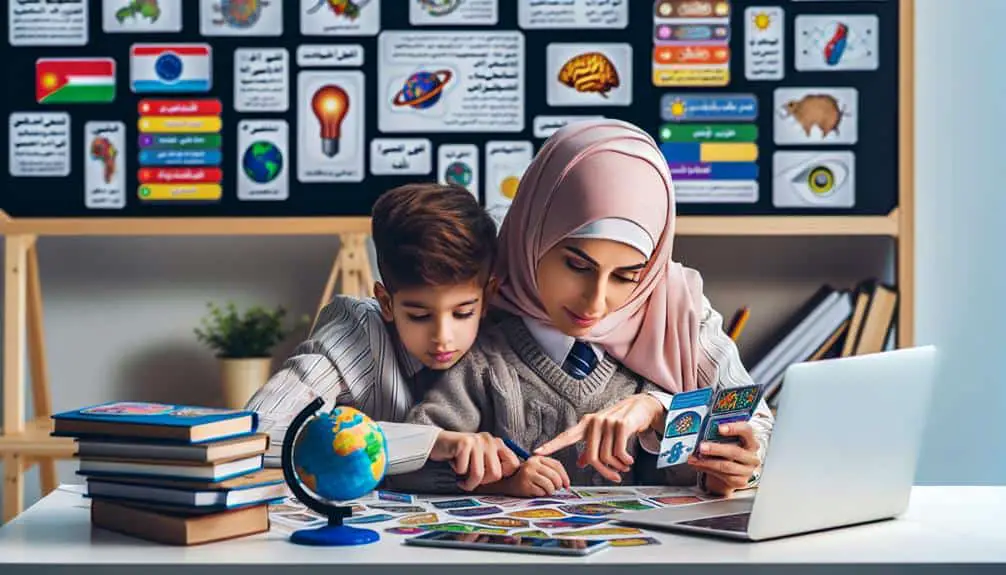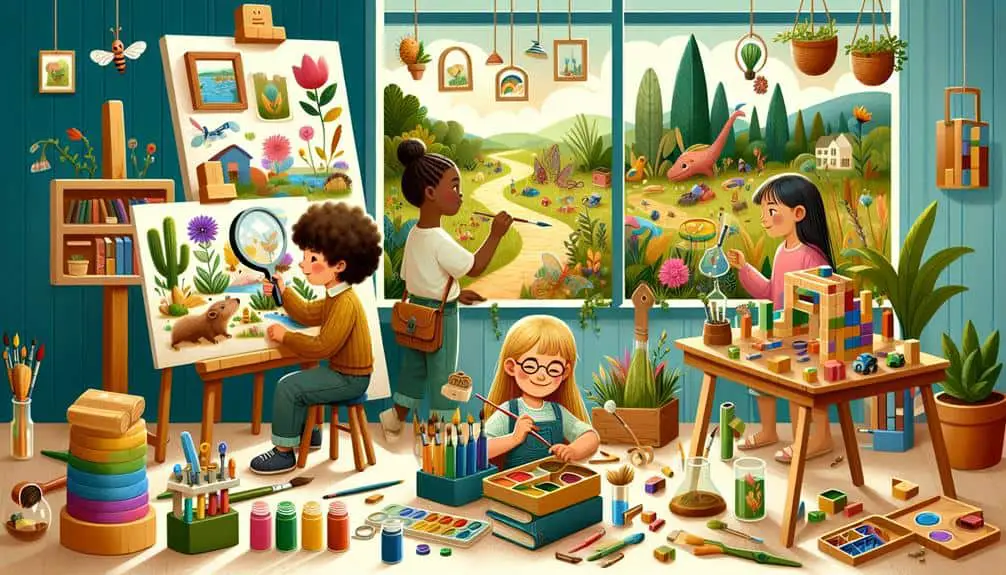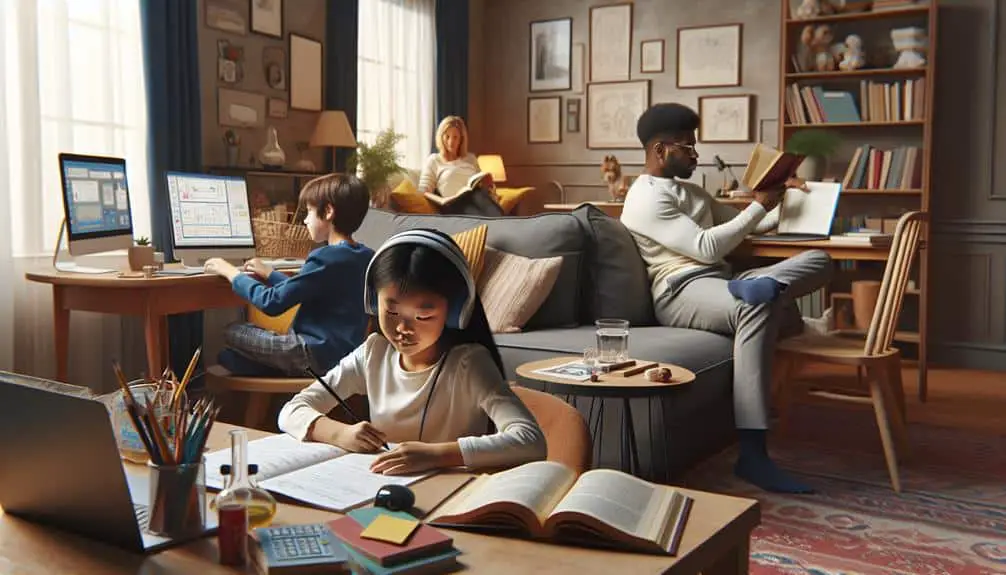Enhance your homeschooling success with visual learning techniques tailored to your child's needs. Visual learners flourish with charts, diagrams, and color-coded resources. Utilize interactive tools like mind mapping and hands-on projects for deeper understanding. Create a clutter-free study space with ideal lighting and ergonomic furniture. Assess progress through targeted quizzes and creative tasks to guarantee comprehension. Discover how these techniques can transform your homeschooling journey and unleash your child's potential.
Key Points
- Utilize color-coding and diagrams for organization and memory retention.
- Incorporate interactive visual aids like videos and illustrations.
- Create a clutter-free, well-lit study space with proper furniture.
- Assess progress through visual quizzes and tasks tailored to visual learning.
- Encourage hands-on projects and creative visual representations for deeper understanding.
Understanding Visual Learners
To effectively cater to visual learners in your homeschooling approach, understanding their unique learning style is essential. Identifying strengths and accommodating weaknesses are key aspects when working with visual learners. Visual learners excel in tasks that involve images, spatial awareness, and color coding. They've a keen eye for detail, often noticing things that others might overlook. Utilizing charts, graphs, diagrams, and color-coded materials can greatly benefit these learners. However, they may struggle with purely auditory instruction or text-heavy materials.
When identifying the strengths of visual learners, it's important to note their ability to recall information through visual cues. They tend to have a strong sense of creativity and excel in tasks that involve visualization. Accommodating their weaknesses involves minimizing text-heavy resources and incorporating more visual aids. By providing visual learners with tools such as videos, infographics, and interactive diagrams, you can enhance their learning experience and help them reach their full potential. Understanding these strengths and weaknesses is vital in effectively teaching visual learners in a homeschooling environment.
Incorporating Visual Aids
Understanding visual learners' needs and preferences, incorporating visual aids effectively enhances their homeschooling experience and boosts learning outcomes. Creative presentations and interactive worksheets can captivate visual learners' attention and make complex concepts more accessible. Utilizing color coding can help organize information and enhance memory retention. Mind mapping, a technique that visually represents ideas and their connections, can aid in brainstorming and understanding relationships between different topics.
When creating visual aids, consider using a variety of formats such as diagrams, charts, and graphs to cater to different learning styles. Visual aids should be clear, concise, and relevant to the material being taught. Incorporating images, videos, and illustrations can also stimulate visual learners' engagement and facilitate better comprehension. Encouraging students to create their visual aids as part of projects or assignments can further enhance their understanding and retention of the material. By integrating these strategies into your homeschooling curriculum, you can effectively support visual learners and optimize their learning experience.
Engaging With Visual Media
Engage effectively with visual media by incorporating interactive simulations that cater to diverse learning styles and enhance comprehension in homeschooling environments. Interactive activities provide hands-on learning experiences, allowing you to actively participate in the educational material. These simulations can range from virtual science experiments to historical reenactments, providing a dynamic way to engage with the content.
Creative projects offer another avenue for visual learning. By creating visual representations of concepts learned, such as constructing dioramas or designing infographics, you can deepen your understanding and retention of the material. These projects encourage critical thinking and creativity while reinforcing the information in a memorable way.
When utilizing visual media in your homeschooling curriculum, consider incorporating a variety of interactive activities and creative projects to enhance your learning experience. By engaging with visual content through simulations and projects, you can make your studies more engaging and effective, catering to different learning styles and maximizing comprehension.
Organizing Visual Study Spaces
Effectively organizing visual study spaces is vital for maximizing learning environments in homeschooling settings. Creating efficient, clutter-free study areas is essential for promoting focus and productivity. Begin by decluttering the space, keeping only necessary materials within reach to avoid distractions. Utilize storage solutions like shelves or bins to maintain organization.
Another important aspect is lighting. Using natural lighting for ideal focus can enhance the learning experience. Position the study area near a window to maximize natural light exposure. Adequate lighting not only reduces eye strain but also enhances alertness and concentration.
Consider the layout of the study space. Arrange furniture to create a functional and comfortable environment. Make sure that the desk or table is at an appropriate height and that the chair provides good support to prevent discomfort during long study sessions.
Assessing Visual Learning Progress
To gauge the progress of visual learning effectively, regularly assess student comprehension through targeted quizzes and visual performance tasks. Tracking progress is vital in ensuring that visual learners are grasping the material presented.
Quizzes can be tailored to focus on visual elements, such as asking students to identify images or diagrams, and performance tasks can include activities like creating visual representations of concepts learned. By incorporating these types of visual assessments into your homeschooling routine, you can gain valuable insights into your student's understanding and retention of visual information.
Visual assessments not only help you evaluate your student's progress but also provide opportunities for them to demonstrate their learning in a way that aligns with their visual learning style. Observing how well they interpret and apply visual information can guide your teaching approach and highlight areas that may require additional focus.
Remember to keep a record of assessment results to track progress over time and make informed decisions about adjusting your visual learning strategies for homeschooling success.




